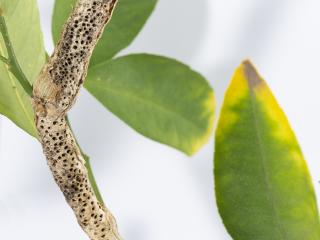Western Australian gardeners are reminded to check citrus trees for the destructive pest, citrus gall wasp, and prune any infested trees before moving them.
The pest damages citrus trees by producing galls that weaken branches, eventually making them unproductive if left unmanaged.
The Department of Primary Industries and Regional Development and industry group WA Citrus are also urging people who have recently purchased citrus trees to check their trees, after citrus gall wasp was recently found in a plant at a Bunbury nursery.
WA Citrus biosecurity representative Helen Newman said now is a good time for people to be moving citrus trees, as galls are visible.
“Moving infested plants poses a key risk of spreading this pest,” Ms Newman said.
“Galls are most visible at this time of year, so infested trees are easier to spot.
“We remind people to check citrus trees for galls, and prune as needed, before they move them. Any infested material must be treated.
“Trees can become newly infested from September onwards, and there may be no visible signs of infestation until the galls are seen the following April or May.
“This means moving trees during the spring-summer period is risky as the pest can unknowingly be spread.”
Ms Newman said gardeners should be checking their trees and undertaking any control, before the wasp starts emerging in September.
“Each wasp lays up to 100 eggs so pruning heavily infested trees and correctly disposing of infested material will stop thousands of wasps emerging and spreading,” she said.
“Home gardeners play a really important role in helping to limit the spread of gall wasp and help keep this pest out of commercial orchards.”
DPIRD research scientist Rachelle Johnstone said pruned plant material needs to be treated before disposal otherwise the wasps could still emerge.
“Galls can be solarised by placing them in a well-sealed plastic bag and left in the sun for at least four weeks. Large galls may need to be chopped up,” Ms Johnstone said.
“If people are unable to prune now, horticultural glue can be used on the galls to trap and kill the wasps as they emerge.
“We remind gardeners in both metropolitan and regional areas to pay close attention to their trees and report suspect detections as soon as possible.”
To report the presence of citrus gall wasp, send a photo and your location (suburb) using the department’s MyPestGuideTM Reporter app (select ‘Citrus gall wasp survey’ project) or contact the Pest and Disease Information Service on (08) 9368 3080, padis@dpird.wa.gov.au
Further information on citrus gall wasp control is available here.


Media contacts:
Jodie Thomson, DPIRD media liaison
+61 (0)8 9368 3937

